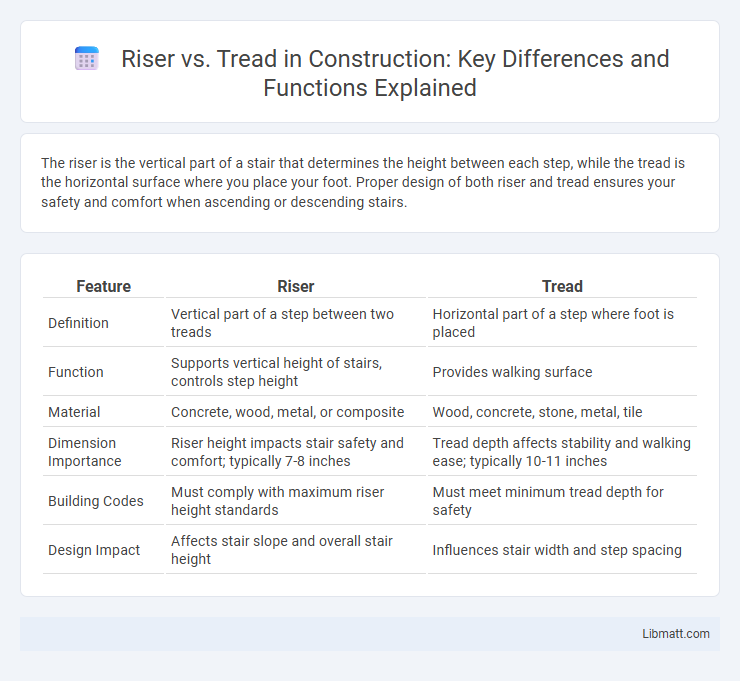The riser is the vertical part of a stair that determines the height between each step, while the tread is the horizontal surface where you place your foot. Proper design of both riser and tread ensures your safety and comfort when ascending or descending stairs.
Table of Comparison
| Feature | Riser | Tread |
|---|---|---|
| Definition | Vertical part of a step between two treads | Horizontal part of a step where foot is placed |
| Function | Supports vertical height of stairs, controls step height | Provides walking surface |
| Material | Concrete, wood, metal, or composite | Wood, concrete, stone, metal, tile |
| Dimension Importance | Riser height impacts stair safety and comfort; typically 7-8 inches | Tread depth affects stability and walking ease; typically 10-11 inches |
| Building Codes | Must comply with maximum riser height standards | Must meet minimum tread depth for safety |
| Design Impact | Affects stair slope and overall stair height | Influences stair width and step spacing |
Introduction to Risers and Treads
Risers are the vertical components of a staircase that determine the height between each step, while treads are the horizontal surfaces you step on, affecting comfort and safety. Proper balance between riser height and tread depth ensures stability and ergonomic efficiency in stair design. Your choice of riser and tread dimensions directly influences the overall functionality and aesthetic appeal of the staircase.
Definition of Risers
Risers are the vertical components of stairs that define the height between each step, playing a crucial role in determining stair height and comfort. They contribute to the overall rise of the staircase, impacting safety and ergonomics by controlling the steepness. Properly measured risers ensure consistent step height, which minimizes tripping hazards and enhances stair usability.
Definition of Treads
Treads refer to the horizontal part of a staircase where users place their feet as they ascend or descend. Each tread typically has a flat surface designed for safe and comfortable footing, and its depth directly affects the overall stair pitch and usability. Proper tread dimensions are crucial for compliance with building codes and ensuring stair safety.
Importance in Staircase Design
The riser and tread are critical components in staircase design affecting safety, comfort, and usability. Proper riser height and tread depth ensure ergonomic stair dimensions that prevent trips and falls. Building codes typically specify riser and tread measurements to optimize stair performance and compliance.
Material Options for Risers and Treads
Risers and treads offer diverse material options tailored to their specific functions and aesthetic requirements. Common materials for risers include wood, MDF, and plywood, which provide durability and ease of painting or finishing, while treads often use hardwood, laminate, or stone for enhanced wear resistance and slip protection. Alternatives like metal and glass are chosen for modern designs, combining structural strength with unique visual appeal.
Building Code Requirements
Building code requirements for risers and treads specify consistent dimensions to ensure safety and accessibility in stair design, with typical maximum riser height around 7.75 inches and minimum tread depth of 10 inches. Codes such as the International Residential Code (IRC) and International Building Code (IBC) mandate uniformity within individual flights to prevent trip hazards, requiring riser and tread variations to be within 3/8 inch. Handrail height and stair width standards are also integrated with riser and tread dimensions to comply with ADA and local building regulations.
Advantages of Different Riser Heights
Different riser heights impact stair safety, comfort, and design aesthetics, with taller risers offering steeper staircases that save space while shorter risers provide easier, safer steps for frequent use. Lower riser heights reduce strain on your legs and minimize trip hazards, making them ideal for homes with elderly residents or children. Balancing riser height with tread depth ensures optimal ergonomics, enhancing stair usability and overall safety.
Tread Depth and Safety Considerations
Tread depth, usually ranging from 10 to 11 inches, provides sufficient space for foot placement, enhancing stability and preventing slips. Risers, with typical heights between 7 to 8 inches, influence overall stair comfort and safety by affecting stride and balance. Proper tread depth combined with consistent riser height reduces trip hazards, promoting safe stair navigation.
Design Aesthetics: Risers vs Treads
Risers and treads play distinct roles in stair design aesthetics, with risers providing vertical surfaces that can be customized with colors, materials, or patterns to enhance visual appeal, while treads offer the horizontal stepping area that often showcases textures and finishes for both safety and style. Open risers create a modern, airy feel by visually reducing the staircase's bulk, whereas closed risers contribute to a more traditional, solid look. Your choice between risers and treads directly impacts the overall design harmony and ambiance of your living space.
Choosing the Right Combination for Your Space
Selecting the optimal combination of riser and tread dimensions ensures both safety and comfort in stair design, with riser height typically ranging from 7 to 8 inches and tread depth between 10 to 11 inches. A higher riser paired with a shorter tread can make stairs feel steep and less accessible, while a lower riser combined with a deeper tread offers a more gradual ascent that suits high-traffic or elderly-friendly spaces. Careful measurement aligned with building codes and personal needs enhances functional flow and aesthetics in residential or commercial staircases.
Riser vs tread Infographic

 libmatt.com
libmatt.com